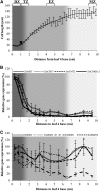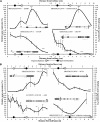Differential methylation during maize leaf growth targets developmentally regulated genes
- PMID: 24488968
- PMCID: PMC3938625
- DOI: 10.1104/pp.113.233312
Differential methylation during maize leaf growth targets developmentally regulated genes
Abstract
DNA methylation is an important and widespread epigenetic modification in plant genomes, mediated by DNA methyltransferases (DMTs). DNA methylation is known to play a role in genome protection, regulation of gene expression, and splicing and was previously associated with major developmental reprogramming in plants, such as vernalization and transition to flowering. Here, we show that DNA methylation also controls the growth processes of cell division and cell expansion within a growing organ. The maize (Zea mays) leaf offers a great tool to study growth processes, as the cells progressively move through the spatial gradient encompassing the division zone, transition zone, elongation zone, and mature zone. Opposite to de novo DMTs, the maintenance DMTs were transcriptionally regulated throughout the growth zone of the maize leaf, concomitant with differential CCGG methylation levels in the four zones. Surprisingly, the majority of differentially methylated sequences mapped on or close to gene bodies and not to repeat-rich loci. Moreover, especially the 5' and 3' regions of genes, which show overall low methylation levels, underwent differential methylation in a developmental context. Genes involved in processes such as chromatin remodeling, cell cycle progression, and growth regulation, were differentially methylated. The presence of differential methylation located upstream of the gene anticorrelated with transcript expression, while gene body differential methylation was unrelated to the expression level. These data indicate that DNA methylation is correlated with the decision to exit mitotic cell division and to enter cell expansion, which adds a new epigenetic level to the regulation of growth processes.
Figures








Similar articles
-
Identification and expression profiles of putative leaf growth related microRNAs in maize (Zea mays L.) hybrid ADA313.Gene. 2019 Mar 30;690:57-67. doi: 10.1016/j.gene.2018.12.042. Epub 2018 Dec 28. Gene. 2019. PMID: 30597233
-
Epigenetic variation, inheritance, and parent-of-origin effects of cytosine methylation in maize (Zea mays).Genetics. 2014 Mar;196(3):653-66. doi: 10.1534/genetics.113.160515. Epub 2013 Dec 27. Genetics. 2014. PMID: 24374354 Free PMC article.
-
Subtle Perturbations of the Maize Methylome Reveal Genes and Transposons Silenced by Chromomethylase or RNA-Directed DNA Methylation Pathways.G3 (Bethesda). 2018 May 31;8(6):1921-1932. doi: 10.1534/g3.118.200284. G3 (Bethesda). 2018. PMID: 29618467 Free PMC article.
-
The integration of leaf-derived signals sets the timing of vegetative phase change in maize, a process coordinated by epigenetic remodeling.Plant Sci. 2021 Nov;312:111035. doi: 10.1016/j.plantsci.2021.111035. Epub 2021 Aug 27. Plant Sci. 2021. PMID: 34620439 Review.
-
Epigenomic landscape and epigenetic regulation in maize.Theor Appl Genet. 2020 May;133(5):1467-1489. doi: 10.1007/s00122-020-03549-5. Epub 2020 Jan 22. Theor Appl Genet. 2020. PMID: 31965233 Review.
Cited by
-
Effects of 5-azaC on Iridoid Glycoside Accumulation and DNA Methylation in Rehmannia glutinosa.Front Plant Sci. 2022 Jun 23;13:913717. doi: 10.3389/fpls.2022.913717. eCollection 2022. Front Plant Sci. 2022. PMID: 35812974 Free PMC article.
-
Developmental Methylome of the Medicinal Plant Catharanthus roseus Unravels the Tissue-Specific Control of the Monoterpene Indole Alkaloid Pathway by DNA Methylation.Int J Mol Sci. 2020 Aug 21;21(17):6028. doi: 10.3390/ijms21176028. Int J Mol Sci. 2020. PMID: 32825765 Free PMC article.
-
Exploration of the Potential Transcriptional Regulatory Mechanisms of DNA Methyltransferases and MBD Genes in Petunia Anther Development and Multi-Stress Responses.Genes (Basel). 2022 Feb 8;13(2):314. doi: 10.3390/genes13020314. Genes (Basel). 2022. PMID: 35205359 Free PMC article.
-
Kinematic Analysis of Cell Division and Expansion: Quantifying the Cellular Basis of Growth and Sampling Developmental Zones in Zea mays Leaves.J Vis Exp. 2016 Dec 2;(118):54887. doi: 10.3791/54887. J Vis Exp. 2016. PMID: 28060300 Free PMC article.
-
Epigenetics for Crop Improvement in Times of Global Change.Biology (Basel). 2021 Aug 11;10(8):766. doi: 10.3390/biology10080766. Biology (Basel). 2021. PMID: 34439998 Free PMC article. Review.
References
-
- Andriankaja M, Dhondt S, De Bodt S, Vanhaeren H, Coppens F, De Milde L, Mühlenbock P, Skirycz A, Gonzalez N, Beemster GTS, et al. (2012) Exit from proliferation during leaf development in Arabidopsis thaliana: a not-so-gradual process. Dev Cell 22: 64–78 - PubMed
-
- Ayliffe MA, Scott NS, Timmis JN. (1998) Analysis of plastid DNA-like sequences within the nuclear genomes of higher plants. Mol Biol Evol 15: 738–745 - PubMed
-
- Cervera MT, Ruiz-García L, Martínez-Zapater JM. (2002) Analysis of DNA methylation in Arabidopsis thaliana based on methylation-sensitive AFLP markers. Mol Genet Genomics 268: 543–552 - PubMed
Publication types
MeSH terms
Substances
LinkOut - more resources
Full Text Sources
Other Literature Sources

